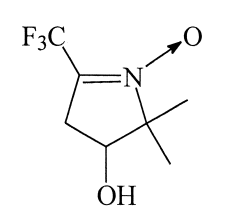Exotic Spin-Traps, FDMPO
After presenting mini-review-style-post dedicated to CYPMPO, today I will present even more exotic beast called FDMPO. As its name suggests, it's DMPO - with three F atoms.

4-hydroxy-5,5-dimethyl-2-trifluoromethylpyrroline-1-oxide is probably one of the most exotic spin-traps. Scholar.Google was able to find only 31 publications ever mentioning it (feb. 2019). In reality, there are maybe 10 good publications.
It has been synthesised for the first time in 2001, but it never became popular as its siblings. In this post, you will find all the references worth reading at this point.
Advantages: adducts are incredibly stable, lasting for a day, it can be detected with NMR [ref 5 as well] (thanks to 19F)
Disadvantage: splitting constants for different adducts are are very similar and it's basically impossible to distinguish between various adducts.
If you want to buy FDMPO, Enzo is selling it. In the brochure, you will find at least 20 more spin traps.
Let's first check the parameters reported for hydroxyl radical
Parameters were obtained both experimentally and theoretically (B3LYP/6-31++G)
- aN = 13.6 G, aF = 2.77 G (Fenton with methanol) [1]
- aN = 13.6 G, aF = 2.70 G (Fenton with ethanol) [1]
- aN = 13.7 G, aF = 2.59 G (Fenton) [1]
- aN = 13.7 G, aF = 2.60 (Fenton with PAA) [1]
- aN = 13.3 G, aF = 2.60 (simulated, B3LYP/6-31++G) [1]
Very similar results were reported in the study that examined taxifolin and the study that examined catalytic effects of activated carbon fibers.
The same study described CH3 adduct and the results were confirmed in [3]:
- aN = 14.6 & 14.9 G (simulated: 14.63 G)
- aF = 1.93 & 2.05 G (simulated: 2.52 G)
The last reported type of adducts included CH2OH and CH3CH2OH:
- aN = 14.08 for MetOH & 14.10 G for EtOH
- aF = 2.13 for MetOH & 2.59 G for EtOH
In Conclusion
If you want to do some sort of "unorthodox" spin-trapping using NMR/MRI? instead of EPR - FDMPO could be interesting to you.
In addition, if you need adducts that will be stable for the whole day, FDMPO could provide very long "exposition time" and consequently very good sensitivity.
The only problem could are hyperfine coupling constants. Basically, you will be able to distinguish between hydroxyl radical and "something else".
This post has been voted on by the SteemSTEM curation team and voting trail.
If you appreciate the work we are doing then consider voting us for witness by selecting stem.witness!
For additional information please join us on the SteemSTEM discord and to get to know the rest of the community!
And I thought my job was boring.
Finding parameters is relatively boring part, but occasionally you can find
interestingless boring facts concerning the application.I will tell you what is my secret... Every time I'm doing something boring, the last tab contains something interesting.
😍 😍 😍